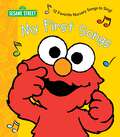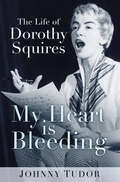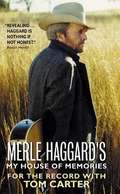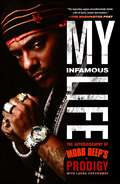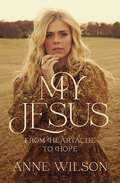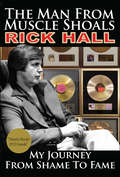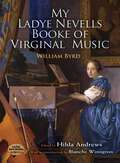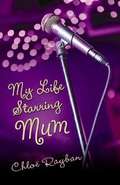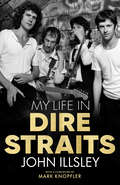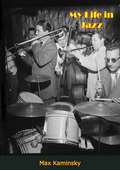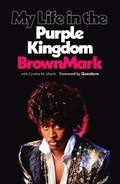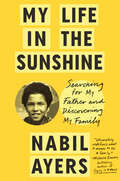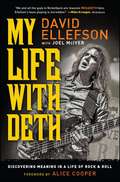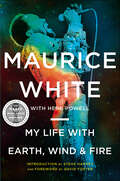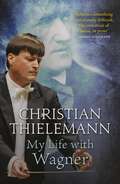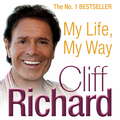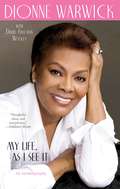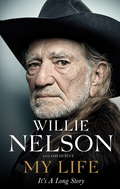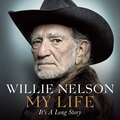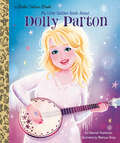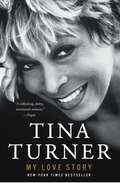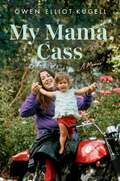- Table View
- List View
My First Songs (Sesame Street)
by Random HouseSing &“Old MacDonald&” and lots of other songs with Baby Elmo and his friends.Sing 12 classic nursery songs with Elmo and his Sesame Street friends! This sturdy board book invites girls and boys ages 1 to 3 to sing along with their favorite Sesame Street Muppets, including Grover, Big Bird, Cookie Monster, Zoe, Bert, Ernie, Telly, Herry Monster, Betty Lou, and Baby Bear. A dozen charmingly illustrated songs make looking and reading as much fun as singing. Sesame Street first harnessed the power of media to educate children more than four decades ago, changing children&’s television forever. Populated with furry creatures and a diverse cast, it was the first show of its kind and provided a blueprint for educational media for generations. There are more than 90 million Sesame Street &“graduates&” in the United States alone, and fans old and young can find their favorite fuzzy friends on PBS, HBO, Sesame&’s award-winning website and chart-topping YouTube channels, as well as in books, toys, apps, healthy foods, and other products that benefit preschoolers and their families. Sesame Workshop, the nonprofit educational organization behind Sesame Street, aims to help kids grow smarter, stronger, and kinder through its many unique domestic and international initiatives. These projects cover a wide array of topics, which address specific needs, such as girls&’ education, financial empowerment, and autism. In 2019, Sesame Street will celebrate its 50th year of distributing quality educational content to families around the world. Sesame Street is the most trusted name in early learning.
My Friend Michael: An Ordinary Friendship with an Extraordinary Man
by Frank CascioEveryone knows Michael Jackson—the myth. This is the revealing true story of Michael Jackson—the man.To Frank Cascio, Michael Jackson was many things—second father, big brother, boss, mentor, and teacher, but most of all he was a friend. Though Cascio was just a few years old when he first met Jackson in 1984, at the peak of the pop star’s career, Jackson was at the center of his life for the next twenty-five years, allowing Cascio to observe firsthand the greatest entertainer the world had ever seen. In that time, he became the ultimate Michael Jackson insider, yet remained publicly silent about his experiences. Until now. In My Friend Michael, Cascio refutes the rumors, lies, and accusations that have accumulated over the years, providing a candid look at the Michael Jackson he knew for more than two decades. Offering an uplifting and definitive account of the legend, Cascio details how he grew up alongside Jackson, traveling the world with him on concert tours and eventually working for him. Through this lens, Cascio captures Jackson’s most private and tumultuous moments, while also setting the record straight on the entertainer’s notorious and misunderstood lifestyle—from his Peter Pan reality and his sexuality to the false allegations against him. As Cascio shows, there was a great deal more to Michael Jackson than the headlines about him have suggested. Cascio reveals his friend in all his complexity, bringing to light his passions and joys as well as his flaws and eccentricities. Including stories about Jackson that have never before been made public, Cascio creates a balanced, human look at the pop star, one that shows Jackson as the very real person he was—a lively friend with an endearingly juvenile sense of humor. What emerges is a clear-eyed yet deeply respectful portrait of Jackson—a man who was at times unremarkably average but also terribly scarred by his life in the spotlight. Packed with never-before-seen photos, anecdotes, and insights, My Friend Michael is a trove of Michael Jackson lore that both celebrates his life and redefines our understanding of the man behind the myth.
My Heart is Bleeding: The Life of Dorothy Squires
by Johnny TudorAs a young girl toiling in a South Wales tin works, Dorothy Squires dreamt of being a singing star, but was ridiculed by all around her. At the tender age of sixteen she escaped the valleys and boarded a train for London. It was here that she met and fell in love with songwriter and band leader Billy Reid, the older man who was to make her a star. The pair became an international success, but the relationship foundered, and Dorothy found herself falling in love with the much younger Roger Moore, a struggling actor who she would spend all her time establishing as a star. Written by Dorothy’s good friend JOHNNY TUDOR, this fascinating first biography of a Welsh singing phenomenon is an unprecedented insight into the glitz and glamour of 1940s and ’50s Hollywood and Dorothy’s triumphant comeback in the 1960s and ’70s.
My House of Memories (For the Record with Tom Carter)
by Tom Carter Merle HaggardIn this riveting personal story, the award-winning, bestselling recording artist takes you on a tour through his house of memories, offering a fascinating look inside his turbulent and successful life. Merle reveals previously untold stories about his birth and troubled upbringing in a converted railroad boxcar. He recalls the loss of his father when he was nine, and how his childish disobedience transformed into full-blown delinquency that landed him behind the cold walls of San Quentin. Having lived a life shaped by violence, gambling, and drugs, he shares the lessons he learned and how he continues to pay for decades of reckless living. He pays tribute to his mother, and relives the painful memory of her death. And he talks about the music he loves, and how it has ultimately defined the man he is.
My Infamous Life: The Autobiography of Mobb Deep's Prodigy (Playaway Adult Nonfiction Ser.)
by Albert Prodigy" Johnson Laura CheckowayFrom one of the greatest rappers of all time, a memoir about a life almost lost and a revealing look at the dark side of hip hop's Golden Era . . . In this often violent but always introspective memoir, Mobb Deep's Prodigy tells his much anticipated story of struggle, survival, and hope down the mean streets of New York City. For the first time, he gives an intimate look at his family background, his battles with drugs, his life of crime, his relentless suffering with sickle-cell anemia, and much more. Recently released after serving three and a half years in state prison due to what many consider an unlawful arrest by a rumored secret NYPD hip hop task force, Prodigy is ready to talk about his life as one of rap's greatest legends. My Infamous Life is an unblinking account of Prodigy's wild times with Mobb Deep who, alongside rappers like Nas, The Notorious B.I.G., Tupac Shakur, Jay-Z, and Wu-Tang Clan, changed the musical landscape with their vivid portrayals of early '90s street life. It is a firsthand chronicle of legendary rap feuds like the East Coast-West Coast rivalry; Prodigy's beefs with Jay-Z, Nas, Snoop Dogg, Ja Rule, and Capone-N-Noreaga; and run-ins with prodigal hit makers and managers like Puff Daddy, Russell Simmons, Chris Lighty, Irv Gotti, and Lyor Cohen. Taking the reader behind the smoke-and-mirrors glamour of the hip hop world, so often seen as the only way out for those with few options, Prodigy lays down the truth about the intoxicating power of money, the meaning of true friendship and loyalty, and the ultimately redemptive power of self. This is the heartbreaking journey of a child born in privilege, his youth spent among music royalty like Diana Ross and Dizzy Gillespie, educated in private schools, until a family tragedy changed everything. Raised in the mayhem of the Queensbridge projects, Prodigy rose to the dizzying heights of fame and eventually fell into the darkness of a prison cell. A truly candid memoir, part fearless confessional and part ode to the concrete jungles of New York City, My Infamous Life is written by a man who was on the front line of the last great moment in hip hop history and who is still fighting to achieve his very own American Dream.
My Jesus: From Heartache to Hope
by Anne Wilson"Whatever you are feeling, God can handle it--all of it. The tears, screams, and questions. God invites you to let Him tend to your heart."In the bluegrass fields of Kentucky, Anne Wilson and her siblings, Jacob and Elizabeth, grew up in the security and love of their family--and Jesus. But when Jacob died in a car accident, Anne was thrust into a painful journey of grief and soul-wrestling that led to God calling her to create songs that glorified Him.My Jesus weaves together Anne's personal story with an encouraging message to anyone longing for God to wipe away their tears.No matter what season of life you're facing, My Jesus comes alongside you to:Show how God can bring purpose out of lossOffer hope in the midst of heartbreakRemind you that God never abandons youDiscover the beauty that can emerge from suffering as you read Anne's story of growing closer to the God who always makes a way.Praise for My Jesus:"I love how Anne Wilson invites us into the cracks and crevices of her life and how she built her life on Jesus. My Jesus is personal, and it takes you on a journey through some of the most foundational parts of Anne's life that develop into a large picture where it is so clear that God was the artist of it all. As I read through each page, I felt like I was at coffee with Anne, hearing her story."--Sadie Robertson Huff, author, speaker, and founder of Live Original"The song 'My Jesus' has impacted so many of our lives in such important ways. Reading this book, being in the moments with Anne and her family, and hearing her faith rise up when her heart was broken, Anne has told a true and deep story that we all need to read."--Annie F. Downs, New York Times bestselling author of That Sounds Fun
My Journey from Shame to Fame
by Rick HallThis is the story of legendary record producer Rick Hall and his historic role in the development of the world-famous "Muscle Shoals sound. ” Rick Hall made music history when he founded FAME Recording Studios, the first professional recording studio in the entire state of Alabama. After producing and engineering the area’s first national hit on Arthur Alexander’s Southern Soul classic "You Better Move On,” Rick went on to earn international fame and eventually a Grammy for a lifetime of achievements. In the days when Martin Luther King Jr. was marching for freedom, Rick proved to be a civil rights pioneer through his music. His records helped introduce white audiences to the black music market and black audiences to the white music market. From the moment "You Better Move On” hit the charts, record executives literally flocked to Muscle Shoals for Rick to produce and engineer a mind-boggling array of major artists, from Aretha Franklin to Bobbie Gentry, from the Osmonds to Alabama. His astonishing production abilities were matched by his incredible versatility. Music fans, history buffs, and others delight to these fascinating tales of how Rick Hall launched the music careers of so many famous artists. Award-winning DVD, Muscle Shoals, included with every book.
My Ladye Nevells Booke of Virginal Music (Dover Music for Piano)
by William ByrdA smaller version of the harpsichord, the virginal enjoyed wide popularity during the 16th and 17th centuries. Based upon a 1591 manuscript of keyboard works, this collection features 42 pieces in modern notation -- a vast amount of neglected concert material for modern pianists and harpsichordists -- plus historic and analytic notes.
My Life Starring Mum
by Chloë RaybanHollywood Bliss Winterman leads a fairly uneventful life at the Convent of the Sisters of the Resurrection boarding school. But everything changes when her mega-famous, rock star mother Khandi yanks Holly out of boarding school, plunks her into a private, secure suite at a posh hotel in London, and promptly forgets that her daughter is even there. With only a mobile phone and pet rabbit to keep her company, Holly's diary of her life (starring her mum) will resonate with any teenage girl who's ever been embarrassed by her mother.
My Life in Dire Straits: The Inside Story Of One Of The Biggest Bands In Rock History
by John IllsleyThe bass player and founding member Dire Straits shares a behind-the-scenes history of the British rock band.One of the most successful music acts of all time, Dire Straits filled stadiums around the world. Their albums sold hundreds of millions of copies and their music—classics like “Sultans of Swing,” “Romeo and Juliet,” “Money for Nothing,” and “Brothers in Arms” —is still played on every continent today. There was, quite simply, no bigger band on the planet throughout the eighties.In this powerful and entertaining memoir, founding member John Illsley gives the inside track on the most successful rock band of their time. From playing gigs in the spit-and-sawdust pubs of south London, to hanging out with Bob Dylan in LA, Illsley tells the story of the band with searching honesty, soulful reflection, and wry humor. Starting with his own unlikely beginnings in Middle England, he recounts the band’s rise from humble origins to the best-known venues in the world, the working man’s clubs to Madison Square Garden, sharing gigs with wild punk bands to rocking the Live Aid stage at Wembley. And woven throughout is an intimate portrait and tribute to his great friend Mark Knopfler, the band’s lead singer, songwriter, and remarkable guitarist.Tracing an idea that created a phenomenal musical legacy, an extraordinary journey of joy and pain, companionship and surprises, this is John Illsley’s life in Dire Straits.Praise for My Life in Dire Straits“A forensic and uplifting journey through the sheer hard work, pitfalls, and thrills of navigating a great rock and roll band to the pinnacle of success. I so enjoyed the ride! Onwards, John!” —Roger Taylor, drummer, songwriter, and founding member of Queen“Reading John Illsley’s book, I relived so many moments. He captures the early days of the “English bands” and their story—the ups and downs, relationships, craziness, and fun. Of course, the music was key. This really happened!” —Mike Rutherford of Genesis“Fascinating. . . . Illsley is brutally frank about the toll that the band’s fame had on his relationships, most notably his marriage (“a victim,” he writes, “of my life on the road”). Fans will be mesmerized.” —Publishers Weekly (starred review)
My Life in Jazz
by Max KaminskyThis is the colourful account of swing trumpeter Max Kaminsky’s life on the road in the formative years of jazz. Originally published in 1963, Kaminsky reminisces about playing with many notables, including Bix Beiderbecke, Fats Waller, Louis Armstrong, Gene Krupa, Artie Shaw, James P. Johnson, Bud Freeman, Pee Wee Russell, Artie Shaw and Jack Teagarden.A wonderful autobiographical work.“Max Kaminsky has written so realistically about the music world that you feel you, personally, were around for the whole great wonderful whirl!”—Jackie Gleason“I found My Life in Jazz absorbing reading and a true representation of the music and the people of the period.”—Bing Crosby
My Life in the Purple Kingdom
by BrownMarkFrom the young Black teenager who built a bass guitar in woodshop to the musician building a solo career with Motown Records—Prince&’s bassist BrownMark on growing up in Minneapolis, joining Prince and The Revolution, and his life in the purple kingdom In the summer of 1981, Mark Brown was a teenager working at a 7-11 store when he wasn&’t rehearsing with his high school band, Phantasy. Come fall, Brown, now called BrownMark, was onstage with Prince at the Los Angeles Coliseum, opening for the Rolling Stones in front of 90,000 people. My Life in the Purple Kingdom is BrownMark&’s memoir of coming of age in the musical orbit of one of the most visionary artists of his generation. Raw, wry, real, this book takes us from his musical awakening as a boy in Minneapolis to the cold call from Prince at nineteen, from touring the world with The Revolution and performing in Purple Rain to inking his own contract with Motown.BrownMark&’s story is that of a hometown kid, living for sunny days when his transistor would pick up KUXL, a solar-powered, shut-down-at-sundown station that was the only one that played R&B music in Minneapolis in 1968. But once he took up the bass guitar—and never looked back—he entered a whole new realm, and, literally at the right hand of Twin Cities musical royalty, he joined the funk revolution that integrated the Minneapolis music scene and catapulted him onto the international stage. BrownMark describes how his funky stylings earned him a reputation (leading to Prince&’s call) and how he and Prince first played together at that night&’s sudden audition—and never really stopped. He takes us behind the scenes as few can, into the confusing emotional and professional life among the denizens of Paisley Park, and offers a rare, intimate look into music at the heady heights that his childhood self could never have imagined.An inspiring memoir of making it against stacked odds, experiencing extreme highs and lows of success and pain, and breaking racial barriers, My Life in the Purple Kingdom is also the story of a young man learning his craft and honing his skill like any musician, but in a world like no other and in a way that only BrownMark could tell it.
My Life in the Sunshine: Searching for My Father and Discovering My Family
by Nabil Ayers&“Nabil traces the image of his father through song. With growing fascination and heartbreak, he draws out meaning from the shadow of absence, and ultimately redefines what it means to be a family.&” - Michelle Zauner, New York Times bestselling author of Crying in H Mart and Grammy nominated musician Japanese BreakfastA memoir about one man's journey to connect with his musician father, ultimately re-drawing the lines that define family and race.Throughout his adult life, whether he was opening a Seattle record store in the '90s or touring the world as the only non-white band member in alternative rock bands, Nabil Ayers felt the shadow and legacy of his father's musical genius, and his race, everywhere. In 1971, a white, Jewish, former ballerina, chose to have a child with the famous Black jazz musician Roy Ayers, fully expecting and agreeing that he would not be involved in the child's life. In this highly original memoir, their son, Nabil Ayers, recounts a life spent living with the aftermath of that decision, and his journey to build an identity of his own despite and in spite of his father&’s absence. Growing up, Nabil only meets his father a handful of times. But Roy&’s influence is strong, showing itself in Nabil&’s instinctual love of music, and later, in the music industry—Nabil&’s chosen career path. By turns hopeful--wanting to connect with the man who passed down his genetic predisposition for musical talent—and frustrated with Roy&’s continued emotional distance, Nabil struggles with how much DNA can define a family… and a person. Unable to fully connect with Roy, Nabil ultimately discovers the existence of several half-siblings as well as a paternal ancestor who was enslaved. Following these connections, Nabil meets and befriends the descendant of the plantation owner, which, strangely, paves the way for him to make meaningful connections with extended family he never knew existed. Despite his father's absence, Nabil, through sheer will and a drive to understand his roots, re-draws the lines that define family and race.
My Life with Deth
by Alice Cooper Joel Mciver David EllefsonOne of the hardest headbangers of heavy metal shares his uplifting and empowering memoir about overcoming addiction and dedicating his life to God.Since 1983, the celebrated metal band Megadeth has sold more than 20 million albums, received eleven Grammy nominations, and built a fan base of millions. Still going strong, they recently toured the world with Metallica, Anthrax, and Slayer. Now, in My Life with Deth, the band's cofounder and bassist David Ellefson tells the whole behind-the-scenes story of the band and his personal journey from suffering to salvation. At first glance, Ellefson's history reads like a how-to manual of excess, from hardcore drugs to x-rated debauchery. But Ellefson goes much deeper, taking us on a gripping journey from his Lutheran upbringing as a Minnesota farm boy, through the culture shock he experienced when he arrived in Los Angeles and entered the music industry, to his drug-fueled Megadeth days, and finally how he beat his addictions and embarked on a path of sobriety and faith, entering a new life of Christian devotion. Today, studying to become a Lutheran pastor, Ellefson presides over MEGA Life! Ministries, a foundation that reaches hundreds of churchgoers every week. Including exclusive interviews with some of the biggest names in American music and filled with life lessons for everyone, My Life with Deth is an inspiring and uplifting profile in courage.
My Life with Earth, Wind & Fire
by Maurice White Herb PowellWith an introduction by Steve Harvey and a foreword by David Foster The Grammy-winning founder of the legendary pop/R&B/soul/funk/disco group tells his story and charts the rise of his legendary band in this sincere memoir that captures the heart and soul of an artist whose groundbreaking sound continues to influence music today. With its dynamic horns, contrasting vocals, and vivid stage shows, Earth, Wind & Fire was one of the most popular acts of the late twentieth century—the band &“that changed the sound of black pop&” (Rolling Stone)—and its music continues to inspire modern artists including Usher, Jay-Z, Cee-Lo Green, and Outkast. At last, the band&’s founder, Maurice White, shares the story of his success. Now in his seventies, White reflects on the great blessings music has brought to his life and the struggles he&’s endured: his mother leaving him behind in Memphis when he was four; learning to play the drums with Booker T. Jones; moving to Chicago at eighteen and later Los Angeles after leaving the Ramsey Lewis Trio; forming EWF, only to have the original group fall apart; working with Barbra Streisand and Neil Diamond; his diagnosis of Parkinson&’s; and his final public performance with the group at the 2006 Grammy Awards. Through it all, White credits his faith for his amazing success and guidance in overcoming his many challenges. Keep Your Head to the Sky is an intimate, moving, and beautiful memoir from a man whose creativity and determination carried him to great success, and whose faith enabled him to savor every moment.
My Life with Wagner: Exploring Opera's Most Enigmatic Composer
by Anthea Bell Christian ThielemannOne of today's most outstanding conductors, Christian Thielemann, composes a brilliant account of the great--and controversial--Richard Wagner. Over a distinguished career conducting some of the world's finest orchestras, Christian Thielemann has earned a reputation as the leading modern interpreter of Richard Wagner. My Life with Wagner chronicles his ardent personal and professional engagement with the great composer, whose work has shaped his thinking and feeling from early childhood. Thielemann retraces his journey around the world with Wagner--from Berlin to Bayreuth via Venice, Hamburg, and Chicago--and combines his analysis with revealing insights drawn from his many years of experience as a Wagner conductor. Thielemann discusses each of Wagner's operas in turn, and his appraisal is illuminated by a deep affinity for the music, an intimate knowledge of the scores, and the inside perspective of a world-class practitioner. And yet for all the adulation Wagner's art inspires, Thielemann does not shy away from unpalatable truths about the man himself, explaining why today Wagner is venerated and reviled in equal measure.My Life with Wagner is a richly rewarding read for admirers of a composer who continues to fascinate long after his death.
My Life with Wagner: Fairies, Rings, And Redemption: Exploring Opera's Most Enigmatic Composer
by Christian Thielemann'Idiosyncratic, humorous, enlightening and written by one of the finest conductors alive ... This is the book to buy if you are going to see Wagner or listen to him at home' LITERARY REVIEWOver a distinguished career conducting some of the world's finest orchestras, Christian Thielemann has earned a reputation as the leading modern interpreter of Richard Wagner. MY LIFE WITH WAGNER chronicles his ardent personal and professional engagement with the composer whose work has shaped his thinking and feeling from early childhood.Thielemann retraces his journey with Wagner - from Berlin to Bayreuth via Venice, Hamburg and Chicago. Next he takes each opera in turn, his appraisal illuminated by a deep affinity for the music, an intimate knowledge of the scores and the inside perspective of an outstanding practitioner. And yet for all the adulation Wagner's art inspires in him, Thielemann does not shy away from unpalatable truths about the man himself, explaining why today he is venerated and reviled in equal measure. The result is a richly rewarding read for admirers of a composer who continues to fascinate long after his death.
My Life with Wagner: Fairies, Rings, And Redemption: Exploring Opera's Most Enigmatic Composer
by Christian Thielemann'Idiosyncratic, humorous, enlightening and written by one of the finest conductors alive ... This is the book to buy if you are going to see Wagner or listen to him at home' LITERARY REVIEWOver a distinguished career conducting some of the world's finest orchestras, Christian Thielemann has earned a reputation as the leading modern interpreter of Richard Wagner. MY LIFE WITH WAGNER chronicles his ardent personal and professional engagement with the composer whose work has shaped his thinking and feeling from early childhood.Thielemann retraces his journey with Wagner - from Berlin to Bayreuth via Venice, Hamburg and Chicago. Next he takes each opera in turn, his appraisal illuminated by a deep affinity for the music, an intimate knowledge of the scores and the inside perspective of an outstanding practitioner. And yet for all the adulation Wagner's art inspires in him, Thielemann does not shy away from unpalatable truths about the man himself, explaining why today he is venerated and reviled in equal measure. The result is a richly rewarding read for admirers of a composer who continues to fascinate long after his death.
My Life, My Way
by Cliff RichardSir Cliff Richard OBE is the biggest-selling artist of all time, selling over 250 million records around the world since he burst onto the music scene in 1958. But how has he kept his appeal all these years? In a world fuelled by drink, sex and drugs, he is perennially attractive without any of those things that keep other singers' profiles high. Now, working with the highly acclaimed biographer and journalist, Penny Junor, Cliff is going to talk freely and frankly about what it is like to be Cliff. Inspirational, hugely talented, a much-loved household name, his story is extraordinary.
My Life, as I See It
by Dionne Warwick David F WooleyDionne Warwick made her singing debut in church at the request of her grandfather, the Reverend Elzae Warrick, when she was six years old. No one knew then that she would become an international music legend, but what she knew--as words of wisdom passed down from her grandfather--was that "if you can think it, you can do it." And she did it. Dionne released the first of more than fifty-six charted hits in 1962 with "Don't Make Me Over," followed by "Anyone Who Had a Heart," "Walk On By," "I Say a Little Prayer," "Alfie," and "A House Is Not a Home," to name a few. She received her first Grammy in 1968 for "Do You Know the Way to San Jose" and later recorded the classic hit "That's What Friends Are For." She was considered the voice of Burt Bacharach/Hal David compositions, and the rest is here, in her first autobiography. Dionne tells the stories of her life from her childhood in East Orange, New Jersey, in a two-family home with her parents, brother, and sister, to now, as she celebrates her fiftieth year in show business. She came by her musical gifts honestly. Her mother, Lee Drinkard Warrick, was a founding member of the legendary Drinkard Jubilairs, which included her mother's siblings Cissy, Marie, Annie, Nick, and Larry. Cissy went on to become a celebrated recording artist in her own right; she lived in the Warrick household, got married, and later gave birth to one of the most popular singers of our time, Whitney Houston. Dionne went on to start her own gospel group with her sister, Dee Dee, called the Gospelaires. Her father, once a Pullman porter, became an accountant, went on to promote gospel records for Hob Records, and wrote a book on gospel music. She attributes her strong family, who are faithful and industrious Christians, for keeping her grounded and giving her the fortitude, as well as the talent, to earn her place among world-class performing artists without losing herself or her soul.
My Life: It's A Long Story
by Willie NelsonFive decades in the music industry, 100 albums, 10 Grammys, the Kennedy Center Honors, and the Country Music Hall of Fame. Add high-profile activism for the legalisation of marijuana, the foundation of a ground-breaking philanthropic organisation, and a much-publicised personal life - Willie Nelson's is a story like no other. Born during the great depression in 1933 and raised by his grandparents, he began singing in dance halls and Honky Tonks at the age of 13, as an escape from working as a cotton picker in the fields of Arkansas. He went on to write some of the most popular country songs of all time, and to record some classic versions of others, including Crazy, Bring Me Sunshine, Always on my Mind and Blue Eyes Crying in the Rain. An American icon who still tours extensively and headlines music festivals, Willie Nelson and his music have found their way into the hearts and minds of fans all over the world.Now 81 years of age, Nelson leaves no experience or moment unturned as he shares the full story. From his drive to write music to the women in his life; from his collaborations to his bankruptcy to the foundation of Farm Aid; Nelson shares, in his distinct voice, soaring highs and painful lows.
My Life: It's a Long Story
by Willie NelsonFive decades in the music industry, 100 albums, 10 Grammys, the Kennedy Center Honors, and the Country Music Hall of Fame. Add high-profile activism for the legalisation of marijuana, the foundation of a ground-breaking philanthropic organisation, and a much-publicised personal life - Willie Nelson's is a story like no other. Born during the great depression in 1933 and raised by his grandparents, he began singing in dance halls and Honky Tonks at the age of 13, as an escape from working as a cotton picker in the fields of Arkansas. He went on to write some of the most popular country songs of all time, and to record some classic versions of others, including Crazy, Bring Me Sunshine, Always on my Mind and Blue Eyes Crying in the Rain. An American icon who still tours extensively and headlines music festivals, Willie Nelson and his music have found their way into the hearts and minds of fans all over the world.Now 81 years of age, Nelson leaves no experience or moment unturned as he shares the full story. From his drive to write music to the women in his life; from his collaborations to his bankruptcy to the foundation of Farm Aid; Nelson shares, in his distinct voice, soaring highs and painful lows.
My Little Golden Book About Dolly Parton (Little Golden Book)
by Deborah HopkinsonHelp your little one dream big with a Little Golden Book biography all about beloved entertainer Dolly Parton! The perfect introduction to nonfiction for preschoolers!What's not to love about Dolly Parton? The multi-talented entertainer is generous, humble, smart, and funny. This Little Golden Book biography shares how someone from incredibly poor beginnings can blossom and persevere to become an award-winning songwriter and singer, actress, author, literacy advocate--and she even has her own theme park! Young girls and boys will definitely feel inspired after hearing Dolly's story.Look for these other Little Golden Book biographies: My Little Golden Book About Kamala Harris, My Little Golden Book About Betty White, My Little Golden Book About Frida Kahlo, My Little Golden Book About Misty Copeland, My Little Golden Book About Ruth Bader Ginsburg, My Little Golden Book About Jackie Robinson, My Little Golden Book About Martin Luther King Jr., My Little Golden Book About George Washington, My Little Golden Book About Abraham Lincoln, My Little Golden Book About Balto, and My Little Golden Book About Johnny Appleseed.
My Love Story: A Memoir
by Tina TurnerIn this New York Times bestseller, Tina Turner—the long-reigning queen of rock & roll and living legend—reveals personal stories she&’s never told before in print or film, about her complicated relationship with her mother, the tragic death of her son, and finally finding true love with Erwin, setting the record straight about her illustrious career in this eye-opening and compelling memoir. From her early years in Nutbush, Tennessee to her rise to fame alongside Ike Turner to her phenomenal success in the 1980s and beyond, Tina candidly examines her personal history, from her darkest hours to her happiest moments and everything in between. My Love Story is an explosive and inspiring story of a woman who dared to break any barriers put in her way. Emphatically showcasing Tina&’s signature blend of strength, energy, heart, and soul, this is a gorgeously wrought memoir as enthralling and moving as any of her greatest hits.
My Mama, Cass: A Memoir
by Owen Elliot-KugellA long-awaited, myth-busting, and deeply affecting memoir by the daughter of legendary rock star &“Mama&” Cass Elliot To the rest of the world, Cass Elliot was a rock star; A charismatic, wisecracking singer from the Rock & Roll Hall of Fame inducted band, The Mamas & The Papas; A legend of Laurel Canyon, decked out in her custom-made Muumuus, glittering designer jewelry, blessed with a powerful, instantly identifiable singing voice which helped define the sound of the 1960s counterculture movement. But to Owen Elliot-Kugell, she was just Mom. In the nearly 50 years since Cass Elliot&’s untimely death at the age of 32, rumors and myths have swirled about, shading nearly every aspect of her life. In her long-awaited memoir, Owen Elliot-Kugell shares the groundbreaking story of her mom as only a daughter can tell it. In My Mama, Cass, Owen pulls back the curtains of her mother&’s life from the sold-out theaters to behind the closed doors of her infamous California abode. Born Ellen Naomi Cohen, the woman who was known to the world as Cass Elliot was decades ahead of her time: an independently minded, outspoken woman who broke through a male-dominated business, a forward-thinking feminist, and a single parent who embraced motherhood from the moment Owen entered the world. From the closely guarded secret of Owen&’s paternity to Cass&’s lifelong struggles with self-esteem and weight, to rumors surrounding her mother&’s death, Owen illuminates the complex truths of her mother&’s life, sharing interviews with the high-profile figures who orbited Cass, as well as never-before-heard tales of her mother and this legendary period of American history. Featuring intimate family and archival photos as well as interviews and memories from famous friends, fans, and colleagues who loved and respected Cass, this book is both a love story and a mystery, a tale of self-discovery and a daughter&’s devotion. At its core, My Mama, Cass is a beautifully crafted testament befitting of Cass Elliot&’s enduring cultural impact and legacy, written by the person who knew and loved her best.
